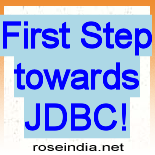First Step towards JDBC
Introduction
This article introduce you with JDBC and shows you how to create a database application to access the databases. For the shake of simplicity, in very first example Access database and Sun's JDBC-ODBC drivers are used. In the later sections we will show you how to use JDBC from your servlets or JSP pages to create dynamic pages or to store the data received from visitors.
What is JDBC?
Java Database Connectivity or JDBC for short is set of Java API's that enables the developers to create platform and database independent applications in java. The biggest advantage of programming in Java is its platform independence. An application written to access the MS Access database on Win 95/Win NT platform can work on Linux against Oracle database, only by changing the name of driver, provided none of the database calls it makes are vendor specific.
What are JDBC Drivers?
JDBC
Drivers are set of classes that enables the Java application to
communicate with databases. Java.sql that ships with JDK contains
various classes for using relational databases. But these classes do not
provide any implementation, only the behaviours are defined. The actual
implementaions are done in third-party drivers. Third party vendors
implements the java.sql.Driver interface in their database driver.
JDBC
Drivers Types
Sun has defined four JDBC driver types. These are:
- Type 1: JDBC-ODBC
Bridge Driver
The first type of JDBC dirver is JDBC-ODBC Bridge which provide JDBC access to any ODBC complaint databases through ODBC drivers. Sun's JDBC-ODBC bridge is example of type 1 driver. - Type 2: Native -API
Partly - Java Driver
Type 2 drivers are developed using native code libraries, which were originally designed for accessing the database through C/C++. Here a thin code of Java wrap around the native code and converts JDBC commands to DBMS-specific native calls. - Type 3: JDBC-Net
Pure Java Driver
Type 3 drivers are a three-tier solutions. This type of driver communicates to a middleware component which in turn connects to database and provide database connectivity. - Type 4:
Native-Protocol Pure Java Driver
Type 4 drivers are entirely written in Java that communicate directly with vendor's database through socket connection. Here no translation or middleware layer, are required which improves performance tremendously.
Links to JDBC Drivers Site Here is the link of some of the site providing the JDBC drivers:
- MERANT
DataDirect provides JDBC driver technology through n-tier,
server-based data connectivity and high-performance,
DBMS-independent JDBC middleware.
- MM
MySQL JDBC DRIVERS - 100% pure java driver for MySQL and is
distributed under the GNU
LGPL.
- The
mSQL JDBC Driver-A pure-java JDBC driver for mSQL was created
and is being maintained by George Reese from The Center for
Imaginary Environments.
A list of currently available JDBC drivers can be found at http://java.sun.com/products/jdbc/jdbc.drivers.html
You can easily find the JDBC
driver for SQL Server and all other database servers by surfing the
following link:
http://industry.java.sun.com/products/jdbc/drivers



